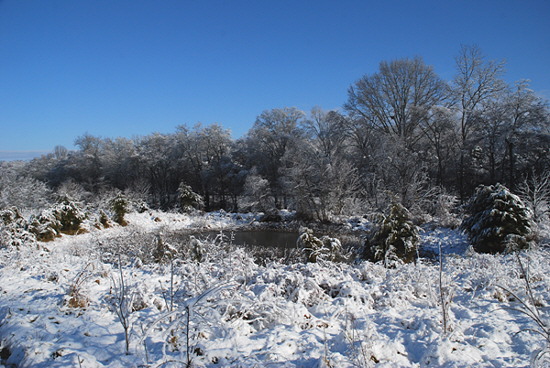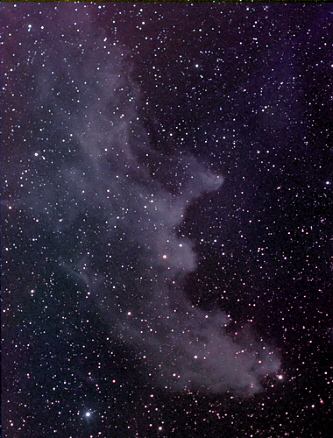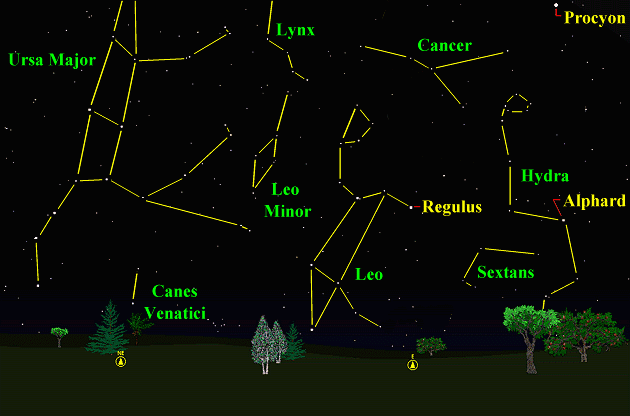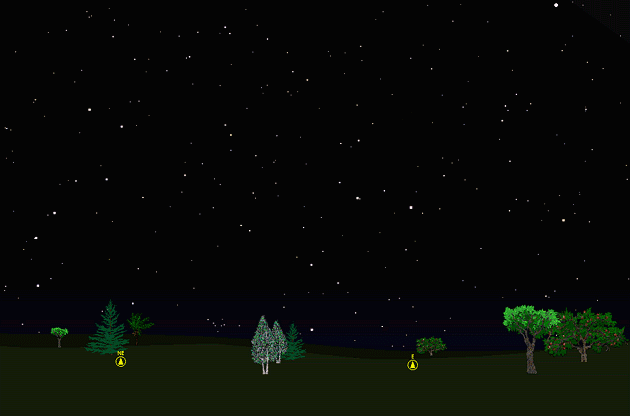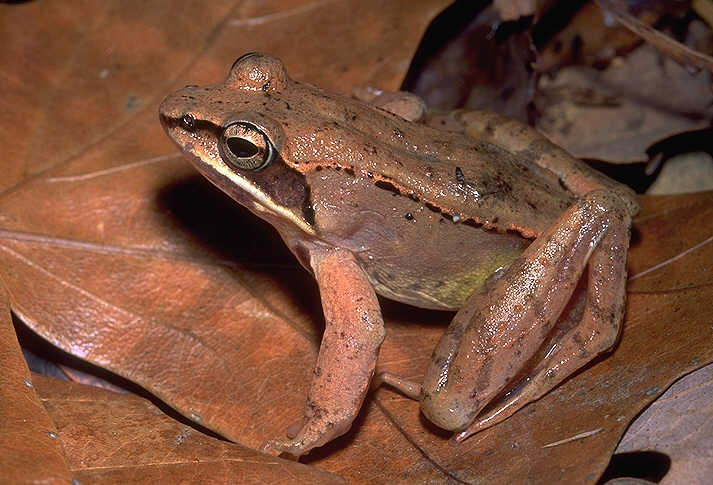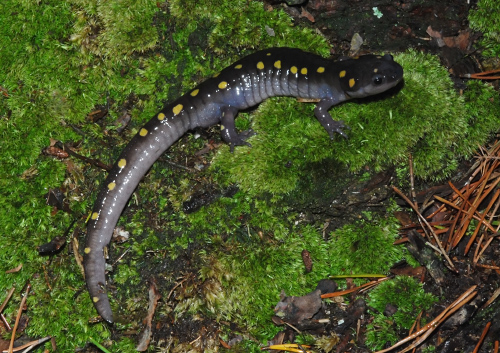The purpose of this feature is to give scout leaders, educators and naturalists an idea of some of the natural events coming up each month. We will try to cover a variety of natural events ranging from sky events to calling periods of amphibians, bird and mammal watching tips, prominent wildflowers and anything else that comes to mind. We will also note prominent constellations appearing over the eastern horizon at mid-evening each month for our area for those who would like to learn the constellations. If you have suggestions for other types of natural information you would like to see added to this calendar, let us know! Note: You can click on the hyperlinks to learn more about some of the featured items. To return to the Calendar, hit the "back" button on your browser, NOT the "back" button on the web page. All charts are available in a "printer friendly" mode, with black stars on a white background. Left clicking on each chart will take you to a printable black and white image.
Notes and Images From December 2008
On December 12th a cold front left two inches of snow on the ground and we awoke to a wintry-looking landscape. We took this image of our pond early in the morning while the tree branches were still covered in snow. There is much natural activity in small ponds such as this one in the winter months. Several of our Tennessee salamanders breed in the winter, frogs and toads forage around the pond on mild winter days, and a world of small but fascinating creatures exists in the icy water. See our section below on winter pond wildlife.
The stars of Orion and Canis Major shine brightly above the southern horizon on these cold clear winter nights. Nebulae abound in this part of the sky, and one of the most interesting is located just a few degrees east of Rigel, the brilliant blue-white star that marks Orion's left foot. Rigel is an extremely luminous supergiant, and is about 40,000 times brighter than our sun. The Witch Head Nebula is illuminated by the light of this star. We took the image at right on December 28th. Rigel is just out of the frame near the upper right corner of the image, in the direction that the "witch" seems to be gazing. Nebulae, like clouds, seem to spark the imagination, and it's easy to imagine the witch head as an malevolent spirit hovering near Rigel but kept at bay by the outpouring of light from the brilliant star. Both Rigel and the Witch Head Nebula are approximately 1000 light years away.
Sky Events for January 2009: Earth reaches perihelion, the point in its orbit closest to the Sun, on January 4th. On January 6th, we will have the latest sunrise for our latitude. Evening Sky: Jupiter and Mercury start out the year only about 2 degrees from each other on January 1st. Look for the pair about 30 to 40 minutes after sunset just above the southwest horizon. Mercury will be slightly above Jupiter. As the days go by Jupiter will sink lower, while Mercury will rise higher till it reaches greatest elongation from the sun on January 4th. Both planets should remain visible for most of the first two weeks of the month. Bright Venus continues to blaze away in the southwestern sky after sunset, and outshines all of the other stars and planets. Venus reaches greatest elongation from the sun on January 14th and will be visible all month. Saturn rises around 9:20pm in Leo. The rings are almost edge-on at this time. Last month we featured an image of the galaxy Messier 74 in Pisces. This month, on the evening January 25th, Comet 85P/Boethin will pass by M-74 to within less than a half of a degree. Both the comet and the galaxy are faint objects, so a clear dark sky is required. If you begin observing early in the evening you should be able to see the motion of the comet as it slowly makes its way past the distant background galaxy. Morning Sky: The Quadrantid Meteor Shower peaks just before dawn on the morning of January 3rd. The peak historically has been brief but can produce good numbers of meteors.
Constellations: The views below show the sky looking east at 9:30pm CST on January 15th. The first view shows the sky with the constellation outlines and names depicted. Star and planet names are in yellow. Constellation names are in green. The second view shows the same scene without labels. The too-long tail of Ursa Major, the Great Bear, has now cleared the horizon and Hydra, the Water Serpent, rears its head menacingly. Its brightest star Alphard is known as "The Solitary One" because of its somewhat isolated location from other bright stars. Canes Venatici, the Hunting Dogs, also make their appearance. Among the fainter constellations visible in the east are Leo Minor, the Small Lion, Cancer, the Crab, and Sextans, the Sextant.
On Learning the Constellations: We advise learning a few constellations each month, and then following them through the seasons. Once you associate a particular constellation coming over the eastern horizon at a certain time of year, you may start thinking about it like an old friend, looking forward to its arrival each season. The stars in the evening scene above, for instance, will always be in the same place relative to the horizon at the same time and date each January. Of course, the planets do move slowly through the constellations, but with practice you will learn to identify them from their appearance. In particular, learn the brightest stars (like Regulus and Procyon in the scene looking east), for they will guide you to the fainter stars. Once you can locate the more prominent constellations, you can "branch out" to other constellations around them. It may take you a little while to get a sense of scale, to translate what you see on the computer screen or what you see on the page of a book to what you see in the sky. Look for patterns, like the stars of the "Big Dipper." The earth's rotation causes the constellations to appear to move across the sky just as the sun and the moon appear to do. If you go outside earlier than the time shown on the charts, the constellations will be lower to the eastern horizon. If you observe later, they will have climbed higher. As each season progresses, the earth's motion around the sun causes the constellations to appear a little farther towards the west each night for any given time of night. If you want to see where the constellations in the above figures will be on February 15th at 9:30pm CST, you can stay up till 11:30pm CST on the January 15th and get a preview. The westward motion of the constellations is equivalent to two hours per month. For instance, if you want to see what stars will be on your eastern horizon on April 15th at 9:30pm CST (3 months later), you would need to get up at 3:30am CST in the morning on January 15th (3 months times 2 hours/month = 6 hours). Recommended: Sky Publishing has a beautiful and compact star atlas, the Sky & Telescope's Pocket Star Atlas. It is destined to become a classic, and is a joy to use at the telescope. A good book to learn the constellations is Patterns in the Sky, by Hewitt-White. You may also want to check out at H. A. Rey's classic, The Stars, A New Way to See Them. For skywatching tips, an inexpensive good guide is Secrets of Stargazing, by Becky Ramotowski. A good general reference book on astronomy is the Peterson
Field Guide,
A Field Guide to the Stars and Planets, by Pasachoff. The book retails for around $14.00. Starry Night has several software programs for learning the night sky. Visit the Starry Night web site at www.starrynight.com for details.
Amphibians:
A lot of things happen with amphibians in January. To see them, though, you have to be out in the sort of weather that makes most people stay indoors. The trick is to go out on mild (50 degrees Fahrenheit or warmer) rainy nights. For safety, it is important that you have another person with you to watch for traffic as you slowly drive the back roads, looking for things that cross the road in front of you. Make frequent stops to listen for calling frogs. We have already had Upland Chorus Frogs calling in December of 2008. In January, calling Spring Peepers are not uncommon (they have been observed calling every month in Tennessee), and Wood Frogs have their short-lived breeding choruses in woodland ponds. Southern Leopard Frogs are also sometimes calling on mild January nights. We have seen Northern Cricket Frogs, Green Frogs, American Bullfrogs and American Toads foraging in January. And just about anything is possible. On January 22, 1999, we found a Eastern Spadefoot out in the stormy weather. That same day a tornado ripped through Clarksville, Tennessee, doing much damage to the Austin Peay campus. January is an exciting time of year to look for herps!
Winter Pond Life: Although some Tennessee wildlife is in a dormant state during the winter months, many species remain active. Small ponds are a good habitat to check for some of these species. Frogs and toads forage around the edges of ponds on mild winter evenings, and you can see them by placing a flashlight or spotlight beside your temple and slowly scanning the banks. It is important to have the beam of light close to your eyes, as this maximizes the amount of reflected eye-shine that you see. You can also do your scan with a spotlight and binoculars. We have found many frogs and toads in the winter this way. Being familiar with the calls of frogs that breed during the winter is also helpful. Upland Chorus Frogs, Spring Peepers and Wood Frogs all call in January.
Tiger Salamanders and Spotted Salamanders breed during the early winter, and you can sometimes find their egg masses in ponds. Rainy nights are the best time to check for adult salamanders, but you can check for the egg masses anytime. Red-spotted Newts can also be seen with a spotlight in the shallow water near the pond's edge.
Some of the most interesting wildlife to be found in winter ponds occurs on a small scale. Many insects and crustaceans can be found in the water or beneath the ice, and collecting a few water samples and examining them with a hand lens or small microscope will give you a window into their world. Freshwater crustaceans like the Daphnia, Cyclops and Seed Shrimp are common in ponds and pools, as are many types of small snails. Dragonfly larvae will spend the winter as larvae before transforming to their summer adult form. In keeping with our astronomical theme this month, the word larva comes from the Latin word for ghost or specter. Both larval and the adult dragonflies are voracious predators. The larval dragonflies are in turn preyed upon by frogs and newts. With the exception of the dragonfly larva, all of the creatures shown at right are less than three millimeters in length. All came from one small sample of water we took by breaking through the ice covering a small pond near Springfield, Tennessee.
Archives (Remember to use the back button on your browser, NOT the back button on the web page!) Natural Calendar December 2008 Natural Calendar November 2008 Natural Calendar September 2008 Natural Calendar February 2008 Natural Calendar December 2007 Natural Calendar November 2007 Natural Calendar September 2007 Natural Calendar February 2007 Natural Calendar December 2006 Natural Calendar November 2006 Natural Calendar September 2006 Natural Calendar February 2006
Natural Calendar
December 2005
Natural Calendar
November 2005
Natural Calendar
September 2005
Natural Calendar
February 2005
Natural Calendar
December 2004
Natural Calendar
November 2004
Natural Calendar
September 2004
Natural Calendar
February 2004
Natural Calendar
December 2003
Natural Calendar
November 2003
Natural Calendar
September 2003 Natural Calendar February 2003 Natural Calendar December 2002 Natural Calendar November 2002 Nature Notes Archives: Nature Notes was a page we published in 2001 and 2002 containing our observations about everything from the northern lights display of November 2001 to frog and salamander egg masses. Night scenes prepared with Starry Night Pro software All images and recordings © 2009 Leaps |
